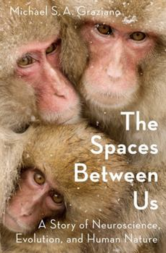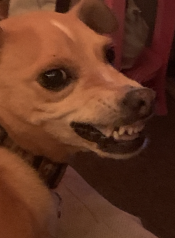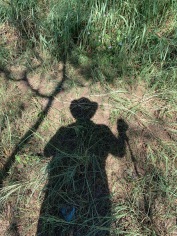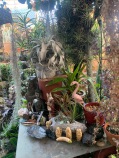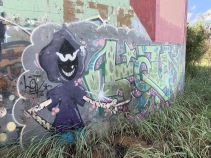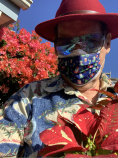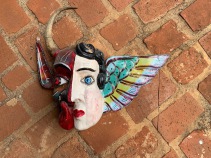Phase Six
I saw a particularly clear example once, back when I worked with primates. A little girl monkey was in a large enclosure filled with climbers and toys that we had collected for her enjoyment. She used to exercise in that enclosure a few hours a day, and I would sometimes sit quietly in a corner and watch just for the pleasure of seeing an excited and playful simian. She would bounce around the place like a gas molecule. On one occasion, as I was watching, I began to notice something peculiar. The pattern was so subtle that I had to collect data in a notebook to see it. Her movements seemed random, jumping to whatever caught her fancy, but when averaged over time, they formed a kind of a doughnut. She simply never went into a specific part of the enclosure. Right at the center of that taboo zone was a stuffed toy monkey that we had put in for her amusement. It obviously didn’t amuse her. She didn’t scream at it, face it, grimace at it, cringe away from it, show any fear or any anxiety. She didn’t show any overt reaction at all. But her ongoing behavior was profoundly shaped by it. She knew it was there and kept a specific distance from it, as if it were ringed by a magic circle. Of course, the magic circle was actually around her. It was her safety buffer with respect to a freaky monkey with button eyes.
Graziano, Michael. The Spaces Between Us . Oxford University Press. Kindle Edition.
I have never liked the term "energy work." That is speaking only for my own use, in my own practice. I get why so many people refer to Phase Six as energy work. Professor Strunk* would criticize it as a "borrowed technicality." Energy belongs to the field of physics and has a certain meaning. The 'energy' of "Energy Medicine" is not that. For all we know it's a unicorn [see Rilke's poem "The Unicorn" ]. This 'energy' is often conflated with the Chinese concept of qi (or chi). We tend to translate this as "vital life force" but it goes beyond that. According to Classical Chinese Philosophy, qi is the force that makes up and binds together all things in the universe. It is paradoxically, both everything and nothing.
To get at what Pauls may have meant when he referred to Phase Six as "working in a person's aura" is not an easy task. Nor do I find it to be a particularly rewarding one. In the immediate field of the person, the practitioner presumably can tune in to the emotional truth of the person. Psychological defenses can be revealed, suppressions and repressions. Pauls assumed that whatever emotions fluxed through him somehow 'belonged' to the other. How was this not simply projection on his part? He would need to be seen as some sort of pure conduit. Some instructors teach that as a practitioner you must be able to recognize when an emotion you are feeling is actually yours or is someone else's that is being repressed or suppressed. On a DVD we have recorded a class where Pauls was discussing the aure. One student asked, "How big is the aura?" Pauls replied something to the effect that is is as big as the distance between you and the other person.
Beginning again, introducing the dog
[Sometimes I come back and finish something I began, Sometimes a new attack, a new and shinier beginning.]
This is Baudie in a rare fierce pose. Monsieur Baudelaire is his more formal name and this pose is more in keeping with his namesake's best-known oeuvre, Les Fleur du Mal (Flowers of Evil). I have been teaching him to assume this pose when I say "snarl." He can't understand why I would want him to do this and is thus reluctant. It is rather against his more dominant nature: open and friendly. This face is mostly assumed in play when he is very serious about his play. I've seen Dobermans back away from this 16-pound demon when he says this face to them.
Out on a walk with Baudie today. We are in a large pet-friendly apartment complex so one can expect, at any time, to meet somebody out walking--or being walked by--a dog. Sometimes Baudie is excited to meet another dog. Some dogs he has shown no interest in. Barely a glance at, not even a desire to sniff where in passing they'd peed. Then another and he's all a-wagging with attention and happy-greeting.
I have no clue what his criteria are, what signals he may be responding to. His olfacrory world is closed to me, what he sees and hears is only vaguely similar. Maybe it is merely whatever mood he's in. ("Sorry, not feeling social at the moment, it's nothing to do with you.") I don't know and can't know.
And am I so different? Some people I will engage with, some I won't. Sometimes I believe it gas to do with some quality or characteristic of the other person, sometimes I thnk it's just me. The curious thing here: My dog and I have very different sensoria, occupy radically different umwelts, his world is largely unknowable to me as is mine to him (we do study one another, learn to at least respect some of the differences). Yet can a say with certainty that I know why approach or avoid another person? Sometimes I tell myself a reason that I believe
